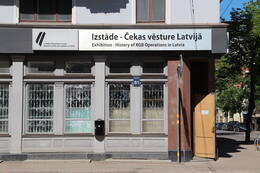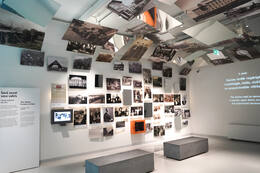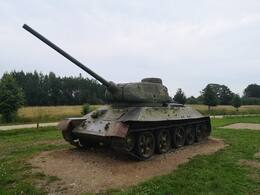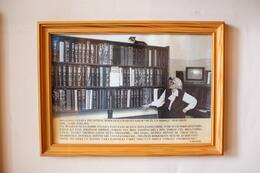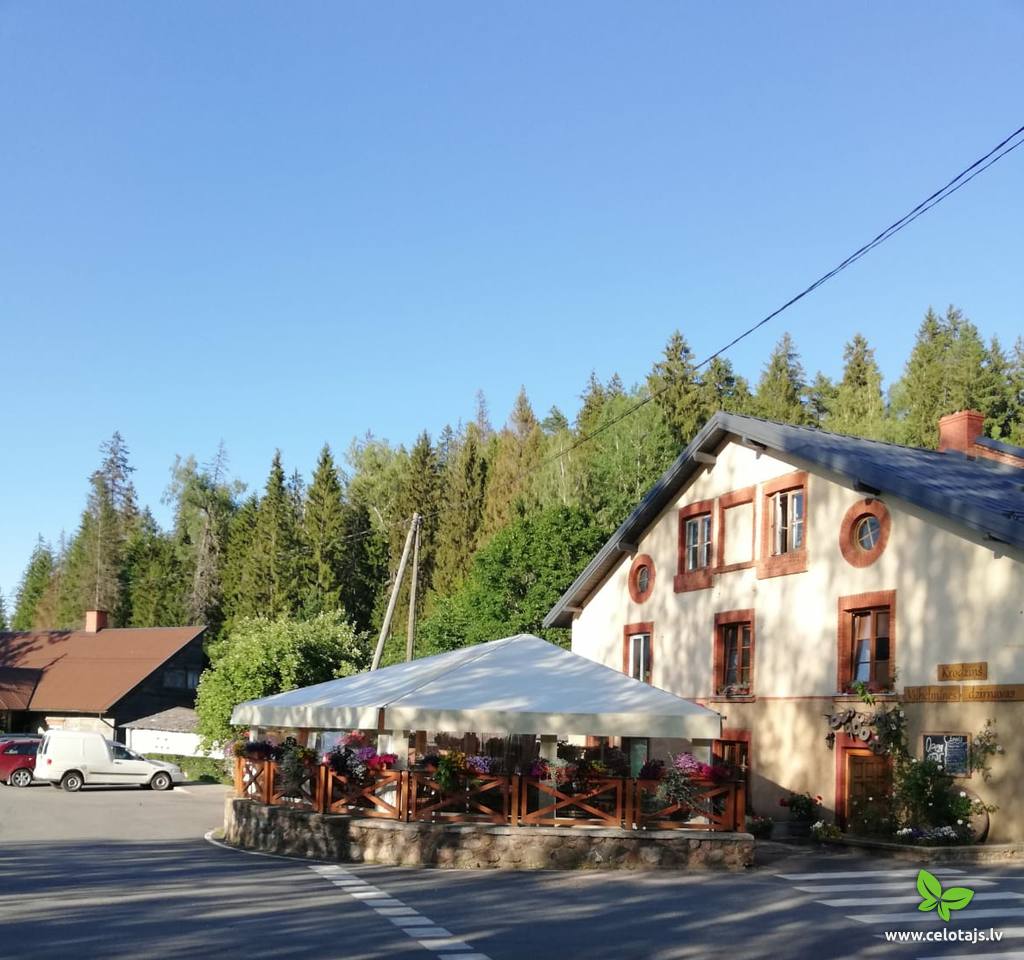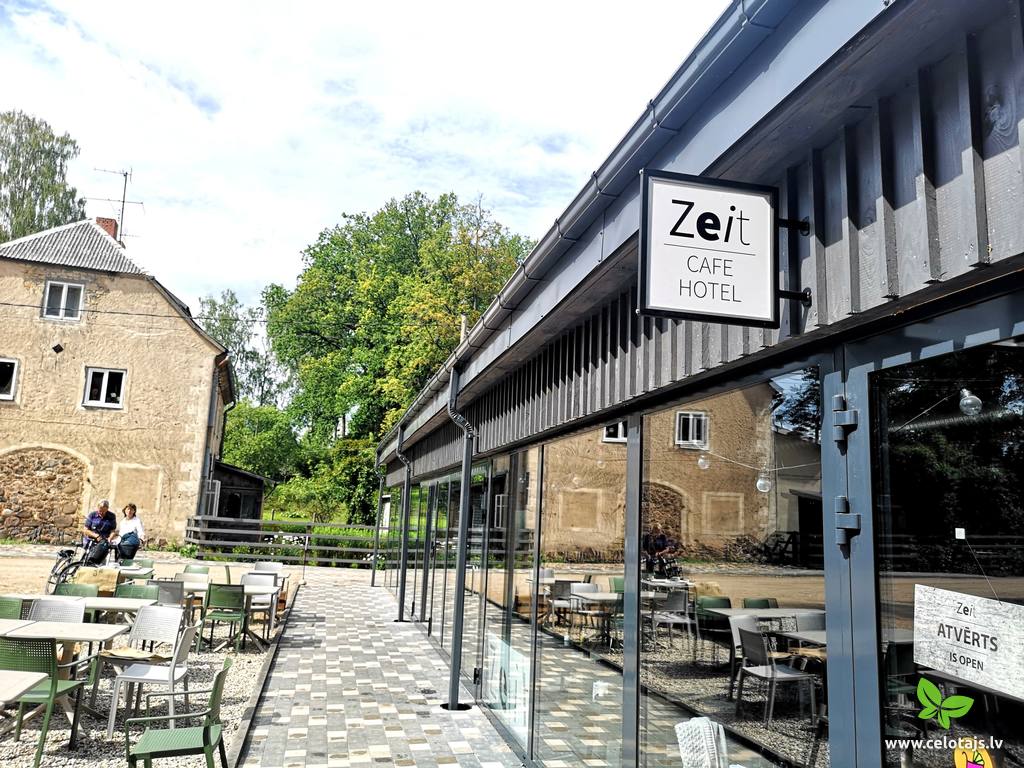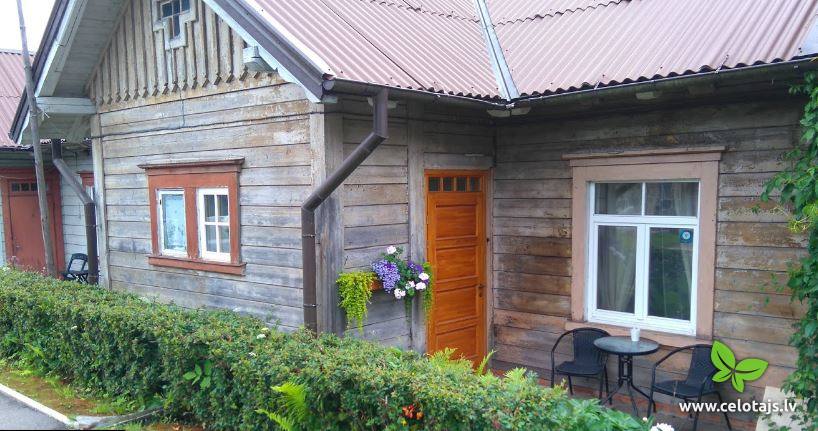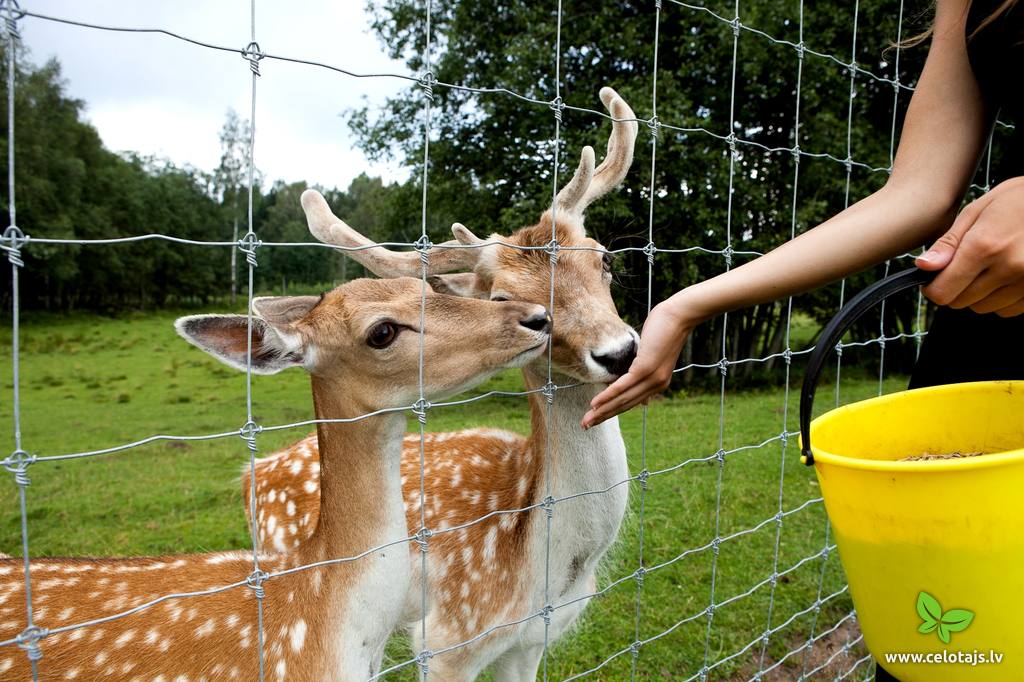Sovietinės okupacijos paveldas Šiaurės Vidžemėje ir Pietų Estijoje
Diena 1.
190 km
Ryga–Aizkrauklė–Sigulda–More–Līgatnė
Praktinė informacija
- Važiavimo atstumas: 190 km
- Dėl atstumų ir laiko šią dieną galima aplankyti 3–4 iš išvardytų lankytinų vietų.
- Bilietus į KGB pastato Rygoje ekskursiją galima įsigyti iš anksto. Ekskursijų laikai ir bilietai www.bezrindas.lv . Daugiau informacijos: +371 27875692. Nerekomenduojama vaikams iki 12 metų.
- Latvijos okupacijos muziejaus darbo laikas okupacijasmuzejs.lv .
- Ekskursiją galima pratęsti praleidus dieną Rygoje, aplankant karinio paveldo objektus, tokius kaip Botherio kapinės ir Žanio Lipkės memorialas.
- Morės mūšių muziejus vasaros sezonu dirba nuo gegužės 1 d. iki spalio 30 d., žiemos sezonu apsilankymus reikia užsisakyti iš anksto.
- Melanijos Vanagos muziejų galima aplankyti tik iš anksto užsiregistravus telefonu +371 29445480.
- Rygos turizmo informacija www.liveriga.com
Lankytinos vietos
Paroda KGB pastate „KGB operacijų Latvijoje istorija“
Buvęs SSRS Valstybės saugumo komiteto (paprastai vadinamas Čeka) pastatas atviras lankytojams. Čia čekistai kalindavo, tardydavo ir žudydavo Latvijos piliečius, kuriuos okupacinis režimas laikė priešininkais. Taip pat eksponuojama Latvijos okupacijos muziejaus ekspozicija apie Čekos veiklą Latvijoje. Siūlomos ekskursijos po kalėjimo kameras, koridorius, rūsį ir kiemą. Namas pastatytas 1911 m. ir yra vienas gražiausių pastatų Rygoje. Liaudyje vadinamas „Kampiniu namu“, jis buvo baisiausias sovietinio okupacinio režimo simbolis Latvijoje ir vienas iš SSRS valdžios ramsčių. Čeka iš Kampinio namo veikė okupacijos metu nuo 1940 iki 1941 m., o vėliau nuo 1945 iki 1991 m. Dešimtys tūkstančių latvių nukentėjo nuo tiesioginio politinio persekiojimo. Kova su sovietų valdžios priešais tęsėsi ir po Antrojo pasaulinio karo. Čekos požiūris į savo veiklą šiek tiek pasikeitė po Stalino mirties. Fizinį kankinimą pakeitė psichologinis teroras. Dauguma Čekos agentų buvo latviai (52 %). Antra pagal dydį grupė buvo rusai – 23,7 %. 60,3 % agentų nebuvo Komunistų partijos nariai. 26,9 % agentų turėjo aukštąjį išsilavinimą. Sistema buvo sukurta taip, kad įtrauktų vietos gyventojus ir taip turėtų didesnę kontrolę visuomenėje. Personalo dokumentai ir tarnybos įrašai yra Rusijoje. Ši medžiaga nebuvo prieinama Latvijos valdžios institucijoms ir tyrėjams.
Latvijos okupacijos muziejus
Muziejuje eksponuojama Latvijos istorija nuo 1940 iki 1991 m., nacistinės Vokietijos ir Sovietų Sąjungos okupacijos laikotarpiu. „Ateities namai“ – tai žinomo Amerikos latvių architekto Gunāro Birkertaus suprojektuoto Okupacijos muziejaus rekonstrukcijos ir išplėtimo projektas, taip pat nauja muziejaus ekspozicija. Ekspoziciją „Čekos istorija Latvijoje“ sukūrė Okupacijos muziejus, ji yra buvusiame SSRS Valstybės saugumo komiteto (KGB) pastate „Kampiniame name“. Latvijos okupacijos muziejus buvo įkurtas 1993 m. Jis pasakoja ilgai slėptą Latvijos valstybės, tautos ir žemės likimo istoriją dviejų užsienio totalitarinių valstybių okupacijos laikotarpiu nuo 1940 iki 1991 m. 2020 m. pabaigoje muziejuje buvo daugiau nei 70 000 įvairių istorinių eksponatų (dokumentų, nuotraukų, rašytinių, žodinių ir daiktinių įrodymų, daiktų ir atminimo dovanų). Muziejaus specialistai įrašė daugiau nei 2400 vaizdo įrašų, todėl tai viena didžiausių okupacijos kolekcijų Europoje. Latvijoje, Lietuvoje ir Estijoje klostęsi įvykiai aiškiai parodo, ką tautoms teko ištverti valdant dviem totalitariniams režimams.
Aizkrauklės istorijos ir meno muziejaus ekspozicija „Sovietmetis“
Minint Latvijos šimtmetį, 2018 m. lapkritį Aizkrauklės seniūnijos kultūros namuose pradėjo veikti Aizkrauklės istorijos ir meno muziejaus ekspozicija „Sovietmetis“ – didžiausia ekspozicija Baltijos šalyse, skirta XX amžiaus (1950–1980 m.) kultūriniam ir istoriniam paveldui. Ekspozicija išdėstyta per tris aukštus ir užima 1060 m2 plotą. Joje pristatomi įvairūs gyvenimo sovietmečiu aspektai: buitis, darbas ir laisvalaikis, švietimas ir kultūra. Pirmajame aukšte eksponuojami sovietmečio automobiliai. Atskirai įrengta biblioteka – Raudonasis kampelis. Įvairialypė ekspozicija kviečia susipažinti su sovietmečio kasdienybe ir butų interjeru – baldais, buities reikmenimis, indais, tekstilės gaminiais ir elektros prietaisais.
Kitos ekspozicijos erdvės skirtos emigracijai, sovietinių laikų represijoms, kasdieniam gyvenimui, medicinai, valstybės institucijoms, turizmui ir sportui, vaikystei bei švietimui. Galima apžiūrėti SSRS karinę atributiką ir uniformas.
Sigulda
Exploring of Sigulda can be started with a visit to Sigulda castle ruins. The construction of the castle was begun by the Knights of the Sword Order in 1207, but in 1236 it was rebuilt for the needs of the Livonian Order. Sigulda castle suffered much from the wars in the second half of the 16th century and in the beginning of 17th century. During the Northern War, it is burned down and is no more restored. Today south-western building of the convent and the tower of the main gate, behind which is the inner forefront of the castle with open air stage, which offers impressive views over the Gauja valley. Currently the reconstruction of castle ruins is in progress. Construction of New castle (owner - Prince Kropotkin) in the South of the Sigulda took place from the 1878 until 1881. From 1923 - 1940 the building was the Palace of Writers, but during the Soviet years - Cardiology sanatorium. Since 2003 Sigulda district council is located there. The manor complex includes wooden house (middle of 19th century), which was Kropotkin's family home, barn (turn of the 18th - 19th century), gardener's house (19th century) and a stone fencing (19th century.) If we make our way from New Castle in a north-eastern direction, after almost 2 km we will reach Vejupite ravine. There you can see the shallow (3.6 m) but high (6.1 m) in Peter's Cave and deep Pucu ravine with Krauklupite. At the conjunction of ravines of both streams rises a Satezele hill fort (plateau 90 x 75 m), where in the beginning of 13th century was the oak castle of Liv land chief (eldest) - Dabrelis. Near can be found Krauklu gorge - ravine of Vejupite left bank, with 11 m high sandstone walls and 5.2 m deep Krauklu cave. At the conjunction of Vejupite ravine and Gauja valley columns Paradise (Gleznotaju) Hill - a very picturesque place, painted and photographed since old times! The Paradise Hill can be reached with a electric vehicle. In the west part of Sigulda is located Ferris wheel (works during the summer) and Air cableway (streetcar) - the only this type of vehicle in Baltics (built in the 1969). Its self-supporting cable extends in 1060 m length and without any support joins the Gauja River valley banks between Sigulda and Krimulda ~ 40 m above Gauja River. Here you can enjoy excellent views! In the south-western part of Sigulda one can walk to mighty Beites precipice, which is split by the deep ravine of stream. On the west side of the ravine lies Keizarskats, which is located ~ 67 m above the Gauja level and offers good views of Krimulda and Turaida castle. Sight place was arranged here already in the 1862 when Russian Tsar Alexander II visited Sigulda. In the eastern part of the ravine wooden Keizarkrēsls (Emperor Stool) is located.
More mūšių muziejus
Muziejus yra Morėje, V319 greitkelio pakraštyje. Jis skirtas 1944 m. rudenį vykusiems Morės mūšiams tarp Raudonosios armijos ir Vokietijos armijos Latvijos legiono. Parodoje eksponuojamas mūšio lauko maketas, ginklai, apdovanojimai, karių uniformos ir karinė įranga. Morės mūšių muziejų ir memorialinį parką įkūrė buvę Latvijos legiono kariai, dalyvavę Morės mūšiuose. Memorialiniame parke yra apkasų, žeminių ir mūšio laukų. Mūšiai Morės apylinkėse buvo tik dalis didelio masto Raudonosios armijos Baltijos puolimo operacijos, kurioje dalyvavo iš viso 900 000 karių ir daug karinės technikos vienetų. Morės apylinkėse buvo įrengta dalis Vokietijos armijos įtvirtinimų sistemos, kurioje Latvijos legionieriai sutrukdė Raudonajai armijai prasiveržti į Rygą. Tai leido Vokietijos armijai išvesti savo pajėgas iš Estijos ir išvengti pralaimėjimo. Raudonosios armijos vadovybė tikėjosi, kad priešo pasipriešinimas netoli Morės bus trumpalaikis, ir atkakliai tęsė nepasiruoštus ir nekoordinuotus puolimus, patirdama didelių nuostolių. Vietos pranašumai ir Latvijos legionierių koviniai pajėgumai suvaidino svarbų vaidmenį tolesnėje karo eigoje. More yra Latvijos legionierių brolių kapinės ir Raudonosios armijos karių kapinės.
Melanijos Vanagos ir Sibiro kasyklos muziejus
Melanijos Vanagos muziejus įsikūręs Amatos kaimo mokykloje, Cėsių savivaldybėje. Muziejuje eksponuojama medžiaga apie rašytojos ir kultūros istorikės Melanijos Vanagos gyvenimą, literatūrinę veiklą, šeimą ir likimą: vaizdo medžiaga apie Sibirą ir ten gyvenančius tremtinius latvius bei Sibiro žeminė, nukelianti lankytojus į rašytojos tremties vietą Tiuchteco rajone, Krasnojarsko srityje. Žeminės išvaizda ir išplanavimas sukuria realistinį gyvenimo toli nuo namų vaizdą. Eminėje eksponuojami unikalūs istoriniai daiktai, atvežti iš Tiuchteto muziejaus: beržo tošies indas, vadinamas „tuesok“, molinis puodelis, vadinamas „krynka“, ir žibalinė lempa. Muziejuje rodomi vaizdo interviu su politiškai represuotais savivaldybės asmenimis ir 18 personažų iš Melanijos Vanagos knygos „Staiga nusikaltėlė: šešiolika metų Sibire“. Muziejaus virtuali paroda „BŪK SAVIMI!“. (http://esipats.lv) pasakojama apie penkių deportuotų vaikų ir jų tėvų, kuriuos sovietų valdžia neteisingai apkaltino „tėvynės išdavyste“, patirtį.
Vietos pavalgyti
The More safari park
This is a breeding farm for wild animals. On 170 hectares, the family breeds European elks, fallow deer and white elks (some 400 head in all), as well as wild boar. A tour will allow you to look at the animals up close. You can taste venison foods such as shish-kabob and goulash, and you can purchase dried venison, salami and canned sautéed meats.
The “Vilhelmīnes dzirnavas” saloon
The saloon is in the historical centre of Līgatne, alongside a pond, and in a building that was once home to the first Līgatne paper factory.
Latvian cuisine: Vidzeme stroganoff, grilled Kolka herring, grilled pork, Amata trout, potato pancakes with cream, pancakes with jam, beer, kvass.
Special foods: A special dessert.
Zeit Hotel
Modern hotel with 9 rooms in Līgatne. Each room has a different story and room image. There are rooms such as "Glamor Room", "Worker's Room", "Dreamer Room", "Gardener's Room", "Her and His Room", "Gambler's Room", "Avanturist Room" and "Writer's Room". There is also a café and rooms for seminars available in hotel.
Vietos apsistoti
Zeit Hotel
Modern hotel with 9 rooms in Līgatne. Each room has a different story and room image. There are rooms such as "Glamor Room", "Worker's Room", "Dreamer Room", "Gardener's Room", "Her and His Room", "Gambler's Room", "Avanturist Room" and "Writer's Room". There is also a café and rooms for seminars available in hotel.
VILHELMINE
Offers overnight stay in Līgatne's historic center, there are 2 well-equipped 4-bed rooms with amenities. Provides their guests with full-service meals and information on recreational facilities in Līgatne. Offers bike rental.
SAFARI PARKS MORE
A guesthouse in the unique environment of a deer garden. The More safari park is ideal for those who wish to forget the speed of the city and spend time in a lovely environment with wild animals at arm’s reach. You can watch various types of deer and boar and feed them by hand. You can also enjoy exclusive dishes made with wild game, as well as with the treasures of Latvia’s forests and countryside.
Jaunlīdumnieki
The holiday house "Jaunlīdumnieki" is located on the steep bank of the Suda River, with beautiful views of the river. The proximity of the river allows you to enjoy a variety of entertainment in the vicinity of the water - swimming in a well-equipped swimming place, fishing, boat rental - kayaks, canoes, SUP board.
A living room with a fireplace and a kitchen corner is on the first floor of the holiday home, on the 2nd floor there is a bedroom with a comfortable double bed and 2 pull-out sofas. There is also a sauna with an electric oven in the house, a sauna ritual with an experienced person is offered. There are 2 separate rooms for a toilet and a shower.
The outdoor area has a pleasant garden corner with garden furniture, where you can dine, sunbath or just relax on your own.
There are several interesting sights nearby - Malpils Manor, Mālpils Dairy, Skulmek Homes and Nature trail along Mergupi and a cycle route (36 km), which presents the most popular sights of Malpils region.
Lygatnėje apsilankykite svetainėje visitligatne.lv




